The Best Snorkel Sites in the Galapagos Islands
 by Tom Shearman on 25th November, 2024
by Tom Shearman on 25th November, 2024
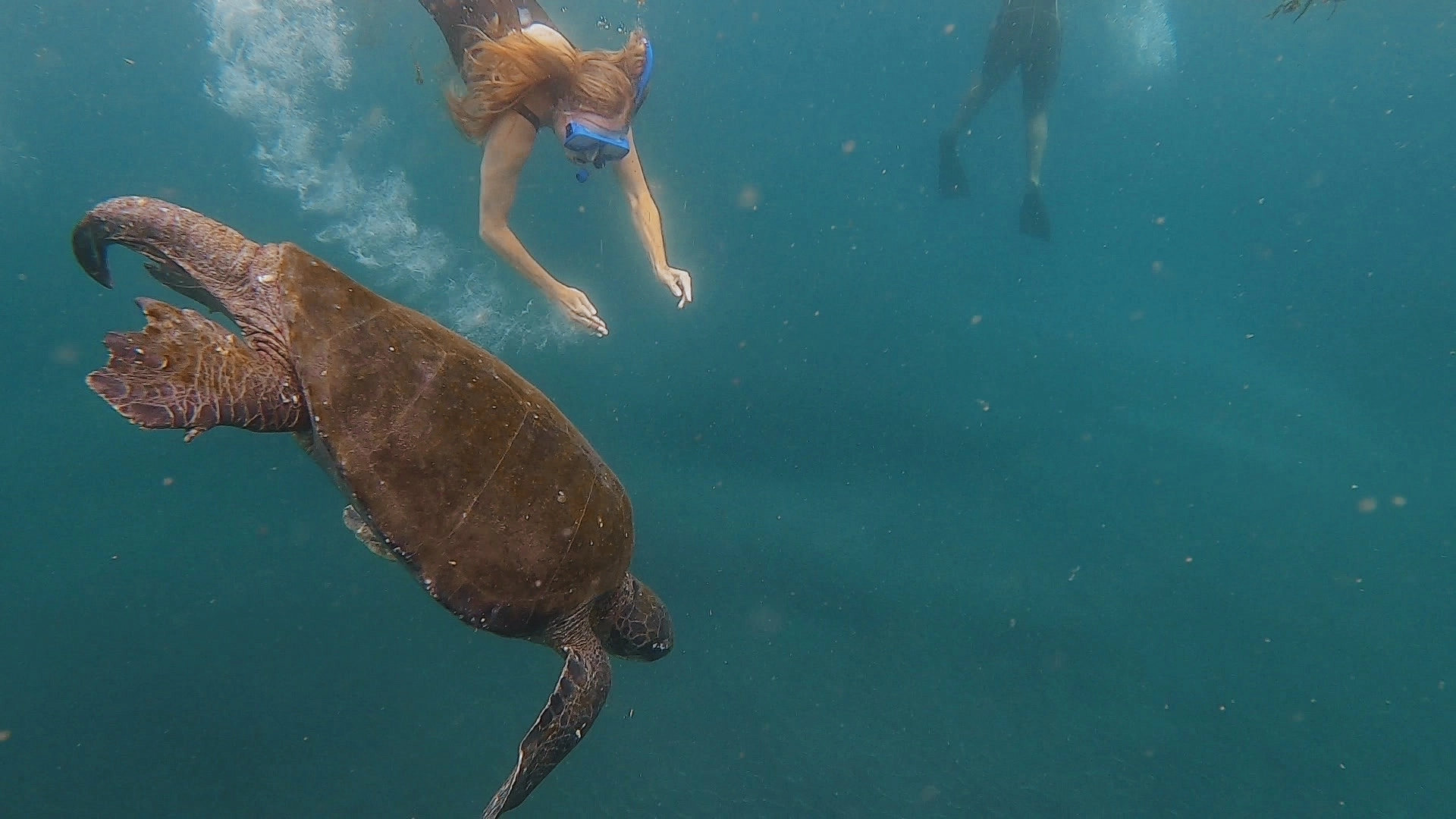
Galapagos Islands’ Best Snorkel Sites
Want to know the best snorkelling sites in the Galapagos Islands? This guide will help identify the top spots, including those only available to guests on Galapagos cruises.
Without a doubt, snorkelling around the Galapagos Islands is a true highlight of any Galapagos holiday. An abundance of curious and beautiful creatures await you once you slip into the sea.
Swim in crystalline waters surrounded by spectacular volcanic calderas. You’ll encounter laid-back turtles, playful sea lions, rapid penguins, marine iguanas, and more.
If you can, practice snorkelling before you go. That said, Most snorkel sites are in calm waters and suitable for people who have never snorkelled. Half of the Galapagos wildlife wonders are above sea level, and the other half are below.
Remember to take an underwater video or camera to capture your experience. Check our range of Galapagos underwater highlights videos and our entire playlist here.
Which Galapagos Animals Can I See Underwater?
Green sea turtles are a huge attraction, swimming calmly and slowly alongside snorkellers. In contrast, darting sea lions are a big attraction, darting between swimmers.
Another top attraction is the marine iguanas, unique to the Galapagos Islands, and Galapagos penguins, the only penguin to live in the tropics.
There’s a good chance you’ll swim with sharks, especially white-tipped reef sharks. Galapagos sharks or hammerheads are around, too.
You’ll need good eyes, but sea horses are often spotted, especially at Los Tuneles in Isabela. And all the while, exotic fish like tropical reef fish dart about. Need more? Graceful manta rays may slide by, or perhaps golden, sting, or eagle rays.
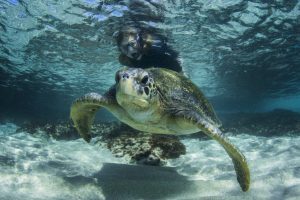
How Many Snorkel Sites Are There in Galapagos?
The Galapagos Islands are a protected national park. Snorkelling is permitted only from approved sites, some only accessible on a guided tour.
People can stay in hotels on three islands and enjoy snorkelling from beaches. Other snorkelling sites are so remote that only cruise ships can reach them.
- Santa Cruz island: 14 snorkel sites
- San Cristóbal island: 11 snorkel sites
- Isabela island: 7 snorkel sites
- Cruise-only: 7 snorkel sites
The Best Galapagos Snorkelling Sites Exclusive to Cruises
The remote western and northern Galapagos Islands are too far from civilisation to reach by speedboat in a day. Longer cruise-based Galapagos tours are the only way to reach these remote corners of the archipelago.
The rewards are plenty: jaw-dropping landscapes frame enchanting coves teeming with wildlife.
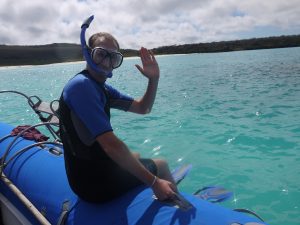
Punta Espinosa, Fernandina
Many consider Punta Espinosa to be the top Galapagos snorkelling site. Located at the northern tip of Fernandina, it is famous for its marine iguanas and Galapagos penguins.
The iguanas are most active between 11 a.m. and 2 p.m., feeding on sea algae. Lucky swimmers may see dolphins, whales, and orcas. Look for red-lipped batfish and frogfish.
Punta Espinosa is only accessible on a Galapagos cruise itinerary that includes the western islands.
Tagus Cove, Isabela
Tagus Cove is opposite Punta Espinosa on Isabela’s western coast. This beautiful cove, complete with pirate graffiti, offers marine iguanas, penguins, and green turtles a home.
The animals feed on the bay’s algae-covered rock bed. There are starfish, sea horses, and flightless cormorants in the area, plus interesting coral formations. Tagus Cove is only accessible on a Galapagos cruise itinerary that includes the western islands.
Next to Tagus Cove is Punta Vicente Rock, a beautiful and protected cove. The cave here is the home to a varied snorkel replete with wildlife. Sea turtles, fish, and sea horses may be seen here. The cave also plays tricks on the light as you enter. It’s a cold snorkel because of the nearby Humboldt Current, but a fantastic one.
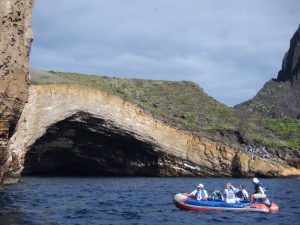
Devil’s Crown, Floreana
The Devil’s Crown (Floreana) is a world famous Galapagos snorkelling site that is only accessible to cruise boats.
This eroded submerged volcano thrusts from the sea in the shape of a crown. Snorkellers jump into a current which pushes swimmers past a beautiful underwater world.
Devil’s Crown features beautiful corals, urchins and colourful fish. There are rays, sea turtles, sea lions, and eels. The current might take some getting used to, especially for those new to snorkelling, but the effort is well worth the reward.
Prince Philip’s Steps, Genovesa Island
This submerged volcano crater offers two great—and distinct—snorkel spots.
On the east side of Genovesa island is Prince Philip’s Steps. This brings a mix of warm and cold waters together and a flood of tropical fish. Keep an eye out for penguins.
Some itineraries snorkel from the beach in the volcano’s centre, where sea lions and reef sharks live. Another spot is where the Genovesa’s crater remains lifted up from the water in a moon crescent on the island’s western edge.
Hammerheads and large manta rays are known to visit this edge of the island, with its deep waters. Genovesa is only accessible on a Galapagos cruise itinerary that includes the northern islands.
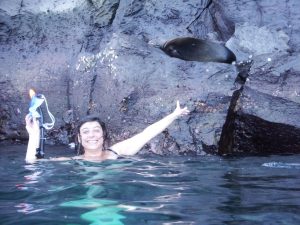
Chinese Hat, Santiago Island
The Chinese Hat, also known as Sombrero Chino, is home to playful sea lions. Here, you may also encounter Galapagos penguins fishing and green turtles feeding on algae. Chinese Hat is only accessible on a Galapagos cruise itinerary.
James Bay, Santiago Island
James Bay offers a great diversity of marine wildlife: tropical fish, moray eels, sea lions, and sharks swim among the octopi and turtles.
Andean Trails’ Tom said: “At James Bay, we floated about over 30 white-tipped reef sharks while marine iguanas zipped across the sea’s surface.” James Bay is only accessible on a Galapagos cruise itinerary.
Punta Mejia, Marchena Island
Calm seas and deep clear water make Punta Mejia a fantastic snorkelling spot thanks to great visibility. Several species of shark frequent the water, as do green sea turtles, rays, and dolphins. The lucky may encounter whales. Punta Mejia is only accessible on a Galapagos cruise itinerary.
Rabida Island
With its famous red-sanded beach, Rabida Island is where snorkellers find tropical fish, angelfish, hawkfish, parrotfish, goatfish, and huge schools of razor surgeonfish live here, with green sea turtles often drifting through. Rabida Island is only accessible on a Galapagos cruise itinerary.
Snorkel Sites Accessible From San Cristóbal Island
San Cristóbal has many fantastic snorkel sites. Indeed, some of the islands close to San Cristóbal offer some of the best snorkelling in the Galapagos Islands.
The famous Kicker Rock is close by, known as Leon Dormido in Spanish, with rays, sharks, turtles and colourful schools of fish. And that’s before considering the stunning Española Island, with its sea lions, rays, sharks, and tropical fish.
The following are snorkel sites accessed on a Galapagos cruise or a day trip from San Cristóbal.
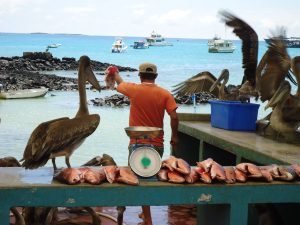
Kicker Rock, near San Cristóbal
Kicker Rock, León Dormido in Spanish, is an iconic Galapagos snorkelling site. Rocks jut out of the water dramatically, with an aperture forming a fantastic channel in which to snorkel.
The channel runs deep. Snorkellers floating above may peer at sea lions, eagle rays, sharks, starfish, and golden rays. The very lucky encounter hammerhead sharks and manta rays.
Cruises can visit Kicker Rock but do not offer snorkelling, so you’ll have to dive or snorkel here on a guided day tour from San Cristóbal.
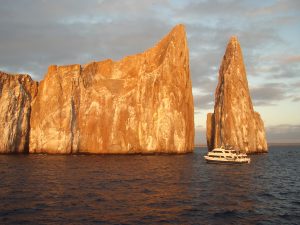
Punta Pitt, San Cristóbal
Punta Pitt is accessible on the “360” San Cristóbal tour or via cruises. Situated on the far northern tip of the island, it’s a dive and snorkeller’s paradise.
Highlights include King angel fish, reef fish, sharks, turtles, morays, sting rays, and sea lions.
Gardner Islet, Española Island
Gardner Island is a natural islet with a rock seabed near Española, the southernmost island of Galápagos. Snorkellers spot sponges, corals, and algae, but the star attractions are twofold.
First, there are the unique marine iguanas, which have green and red colouration. For many snorkellers, however, Gardner is best remembered for playful interactions with Galápagos sea lions. Fins may be nipped, or the creatures swim right up to your mask before a last-minute veer away. It’s definitely a highlight.
La Loberia Beach, Floreana
La Loberia Beach is a beautiful islet. Its turquoise waters and crystalline sands make this one of the Galapagos’ most idyllic beaches.
Underwater are sea turtles, tropical fish, and the ever-joyous sea lions, which you can snorkel alongside. The protection offered by the rocky outcrops usually makes La Loberia one of the calmer snorkels.
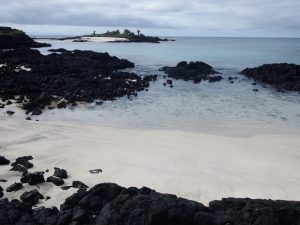
San Cristóbal Snorkel Sites Accessible from Hotels
People staying in a Puerto Baquerizo Moreno hotel have many snorkelling options within walking distance or a taxi ride from the capital.
These are the best snorkel sites on San Cristóbal island.
Playa Baquerizo Beach, San Cristóbal
Playa Baquerizo is a horseshoe-shaped cove with a long and white sandy beach on the western side of San Cristóbal Island. This spot may form part of a cruise itinerary or can be visited independently from Puerto Baquerizo Moreno.
It’s a 45-minute hike from Tijeretas Hill to Playa Baquerizo. Entry into the water from the shore can be tricky if the waves are up. Sticking close to the rocks is recommended. Turtles, rays, sea lions, and tropical fish are here, while blue-footed boobies may swoop overhead.
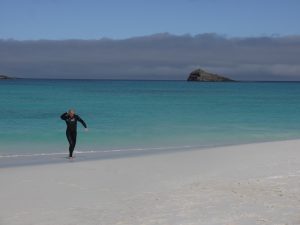
Muelle Tijeretas Dock, San Cristóbal
Just before Playa Baquerizo is Muelle Tijeretas. You’ll often be surrounded by playful sealions vying for your attention. Under the surface, green sea turtles abound.
Punta Carola Beach, San Cristóbal
This 300m-long beach is about 1.5 miles (2.5km) north of San Cristóbal’s capital, Puerto Baquerizo Moreno.
People snorkel and surf here. The biggest attraction is the sea lion colony and the marine iguanas. Sea turtles and lava lizards are also a draw to this famous Galapagos beach. Read our Galapagos beaches guide for more.
Can’t make it that far? Try Playa Mann Beach, which has a sea lion colony and is much closer to town.
Puerto Chino Beach, San Cristóbal
The often deserted Puerto Chino beach is a 15-mile (24-km) taxi ride from Puerto Baquerizo Moreno.
Fine white sand and rocky outcrops frame turquoise waters that contain green turtles, sting rays, and sea lions. There are no facilities or shade here, so watch for mosquitoes and biting flies.
Bahia Rosa Blanca Beach, San Cristóbal
Bahia Rosa Blanca lies on San Cristóbal’s eastern shores, accessible only by cruises and the famous San Cristobal “360” day tour.
The bay’s rock pools create a sheltered area that marine and birdlife find ideal for raising their young. Snorkellers might swim alongside sea turtles, rays, tropical fish, and sharks.
Other beaches visited on the 360 include Ochoa Beach (sea lions, rays, turtles) and Lobos Island, just in front.
The Best Snorkelling Sites Santa Cruz, Galapagos
Santa Cruz Island has many top snorkelling sites to enjoy. Some are accessible from cruises only, others on day tours, and there is plenty to enjoy within walking or taxi distance from your hotel in Puerto Ayora.
There are incredible beaches, chances to see many of the emblematic Galapagos species and a fantastic time to be had swimming with sea lions.
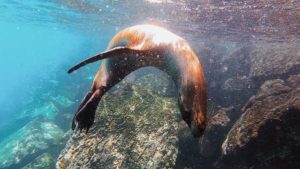
Snorkel Sites Accessible From Santa Cruz Island
Some snorkel sites close to Santa Cruz are only accessible via a cruise package or on a day tour from Puerto Ayora. Those on day tours take a speedboat from the port to the site and return the same day, with lunch included.
Plazas Islets
The two Plazas lie just off Santa Cruz island’s east coast: Isla Plaza Norte (North Plaza) and Isla Plaza Sur (South Plaza). Visitors must take a cruise or a group day trip to reach these beautiful islands.
South Plaza is covered in red and purple Sesuvium, which looks like a carpet. A 1,000-strong (male) Galapagos sea lion colony lives here, and iguanas—curiously, land and marine iguanas interbreed here. In the water, the coral reefs attract reef sharks, colourful fish, manta rays and sea lions.
North Plaza is not open to visitors and is used strictly for research purposes.
North Seymour Island
North Seymour lies on Baltra’s northern tip, itself north of Santa Cruz. You might see it as your plane lands at Baltra airport.
Snorkelling at North Seymour is a real highlight. One of the Galapagos’ largest sea lion colonies lives here, alongside thousands of colourful fish. There’s more: sometimes, hammerhead sharks swim past, as do reef sharks, turtles, sting rays and manta rays.
Visits here are with cruise boats or on day tours only. A host of birds, including orange-coloured land iguanas, frigate birds, and more, are to be seen.
Bartolomé Island, Pinnacle Rock
Bartolomé Island and the iconic Pinnacle Rock are among the most sought-after destinations in the Galapagos Islands. The site offers 360-degree views across the archipelago, a stunning rock formation, and some of the best snorkelling around.
The deep blue sea and golden sands are home to Galapagos penguins, playful sea lions, turtles, rays, sharks, and colourful fish. The protected bay also makes it a popular place for those just starting to snorkel, with easy entry into the sea from a sandy beach. Remember to look up; you might see a Galapagos hawk.
Green sea turtles nest here from January to March. Visit Bartolomé Island on a cruise or a day tour from Santa Cruz.
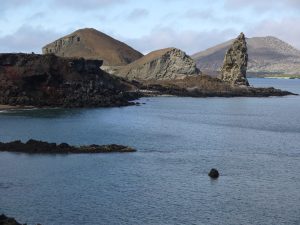
Daphne Mayor Island
Cruises and day tours don’t visit Daphne Mayor, as the island is protected for research purposes. There are trips that head to the nearby Bahia Borrero and a snorkel in the sea nearby.
Look for rays, sharks, turtles, and tropical fish when snorkelling close to Daphne Mayor Island.
Pinzon Island
Isla Pinzon, also known as Duncan Island, lies almost equidistant between Santa Cruz, Isabela, and Santiago. It’s not the most popular destination, which is a pity because the snorkelling is fantastic.
Open-sea snorkelling in protected bays brings wildlife rewards: Galapagos penguins, sharks, turtles, rays, and, on rare occasions, dolphins. Book a day trip from Santa Cruz or check cruise itineraries.
Santa Fé Island
To the southeast of Santa Cruz are Santa Fé Island and Barrington Bay. Snorkellers are often enchanted by swimming with large numbers of sea lions here. Reef fish, sharks, and rays are also often found in the secluded cove’s turquoise waters.
Most snorkel trips explore Barrington Bay and include an island visit to see the two land iguana species that live on Santa Fé. Visit this island on a cruise or as part of a day trip from Santa Cruz.
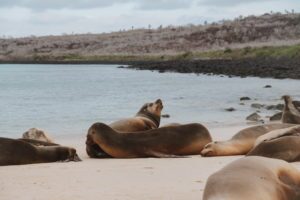
Santa Cruz Island Snorkel Sites Accessible from Hotels
There are plenty of great snorkel sites people can visit when staying in a Santa Cruz hotel.
Tortuga Bay, Santa Cruz
Tortuga Bay Beach is a beauty. The 3km of paved walkways from Puerto Ayora to Tortuga Bay take about 45 minutes to walk, but the payoff is justified.
Keep an eye out for wildlife en route to what many think is the Galapagos’ most beautiful beach. The white sand is home to marine iguanas, baby reef sharks, turtles, and excellent surfing waves. The waves may stir up sediment, making the usually clear water a little murky near the shore.
Visitors sunbathe, kayak, surf, swim, and snorkel, usually around the wavey Playa Brava. Take care when entering the water; there are currents. Tortuga Bay’s calmer beach is Playa Mansa, where you may encounter marine iguanas and tropical fish.
The mangroves that surround Tortuga Bay provide a fertile breeding ground for wildlife. Blue-footed boobies and marine iguanas love the area.
Las Grietas, Santa Cruz
Las Grietas is a popular snorkelling spot near Puerto Ayora, and it is often included on bay tours from the island.
Translating as ‘The Crevasse,’ Las Grietas is a canyon formed from lava rock. Ocean water fills the fissure between two cliffs, creating fantastic underwater rock formations. Sea lions and colourful fish dart around this striking and photographic attraction.
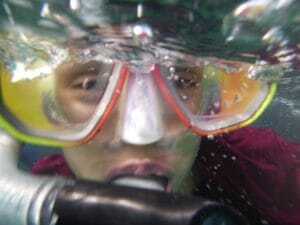
Playa de Los Alemanes Beach, Santa Cruz
Next door to Las Grietas is La Playa de Los Alemanes or the German’s Beach.
The best way to access La Playa de Los Alermanas is to take a $1 water taxi from Puerto Ayora port. Low tide is best, revealing a sandy beach. Waters are usually calm, making it perfect for families.
La Playa de Los Alemanes is flanked by mangroves that are home to birds. A snorkel here may be alongside rays, sea turtles, and colourful fish, perfect for beginners.
Station Beach, Santa Cruz
Station Beach forms part of the Charles Darwin Research Station. It’s one of the few free places near Puerto Ayora where swimming and snorkelling are possible. Despite that, Station Beach is often quiet.
Marine iguanas, tropical fish, and the odd sea lion may accompany you on a refreshing dip.
The research station’s second beach is La Ratonera. Surfers enjoy the waves here, and snorkellers a refreshing dip among the fish and occasional marine iguana.
El Garrapatero Beach, Santa Cruz
The white sands of El Garrapatero beach are 20km northeast of Puerto Ayora, usually reached by taxi. You’ll also have to walk 15 minutes from the drop-off to the beach and arrange a lift back and pick-up time.
El Garrapatero’s lagoon features flamingos, and visitors come here to swim, kayak, sunbathe, and, of course, snorkel. Snorkellers may encounter marine iguanas, colourful fish, sea lions, and sea turtles. The very lucky may see the Galapagos penguin.
Isabela Island Snorkelling Sites
Isabela, the largest island in the archipelago, is home to some of the best snorkel sites in the Galapagos Islands. The good news is that only Tagus Cove requires a cruise to visit. The rest await day trippers or those willing to walk or cycle to some underwater heavens.
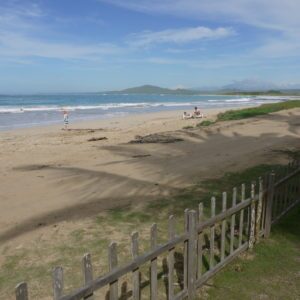
Los Tuneles, Cabo Rosa, Isabela
Los Tuneles—The Tunnels in English—is a snorkel trip that cannot be missed. Snorkellers access this site by staying overnight at Isabela’s capital, Puerto Villamil.
A 45-minute speedboat ride takes people to the beautiful Cape Rosa on the island’s western side. Keep an eye out for manta rays en route.
Most day tours start with a walk around the lava tunnels, which give the tour its name and span the pristine waters. From above, sea turtles, penguins, and rays can be seen. Hopping in the water, you’ll soon be among the rich marine fauna—you might even spot a sea horse as this is the Galapagos’ prime spot.
Some tours also stop for a snorkel at the nearby El Finado Bay before returning to Puerto Villamil. El Finado is a sheltered cove is home to sea turtles, sea lions, rays, sea horses, sharks, and sometimes Galapagos penguins.
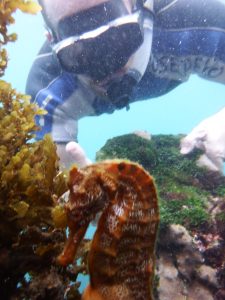
Concha de Perla Lagoon, Isabela
A short walk (15-20mins) from Puerto Villamil is Concha de Perla (Pearl Shell). Guides aren’t necessary as it’s out the National Park regulations.
This sheltered lagoon is, as the name suggests, a real pearl. Snorkelling here is best at low tide when you might encounter sea lions, Galapagos penguins, sea turtles, iguanas, and more wildlife.
Las Tintoreras, Isabela
Another site close to Puerto Villamil is Las Tintoreras. There is a walk that offers a view down into lava canals where multitudes of white-tipped reef sharks relax.
Snorkelling at Las Tintoreras offers the chance to swim with sharks, sea lions, reef fish, stingrays, white-tipped sharks, and barracuda.
Puerto Villamil Beach, Isabela
Isabela’s town lies on a gorgeous 4km white-sand beach from which it’s possible to snorkel.
The main attractions are its proximity to hotels, colourful fish, and marine iguanas. You might spot some pelicans fishing. Take care with waves—the sea can get rough—and currents. Surfers like this beach to catch waves, and often there are volleyball matches on the sands.
At the western end of the town beach is La Playita Beach, a small cove looking at town. It’s a nice place to swim after cycling to the Wall of Tears, and you’ll encounter few people.
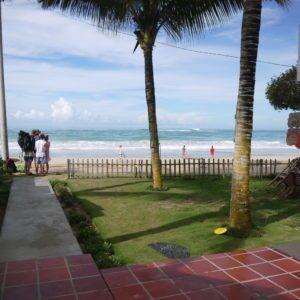
Tortuga Island, Isabela
Tortuga Island (or Brattle Island) is a deepwater snorkel for those hunting hammerhead sharks and manta rays.
It’s a 45-minute speedboat crossing from Puerto Villamil to Tortuga Island, a small islet to the southeast of town. The island’s half-moon shape comes from it being an extinct volcano rim.
To snorkel here, you’ll need to take a day trip from Isabela. Some operators offer fishing as part of the trip.
4 Hermanos & Cartago Bay
At Isabela’s eastern rump lie four islands called Los Cuatro Hermanos, or the Four Brothers.
A speedboat takes about an hour to reach the islands. Deep sea snorkelling here may bring the swimmer into contact with hammerhead sharks, manta rays, and Galapagos sharks. A shallow water snorkel at Cartago Bay offers sea turtles, rays, sharks, and fish.
Some day tours from Isabela may include fishing for tuna and other deepwater fish.
Extra Information About Snorkelling in the Galapagos Islands
Below is some more advice to help you get the most out of your snorkelling experience in the Galapagos Islands.
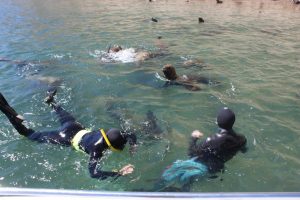
When’s the Best Time to Snorkel in Galapagos?
Every month brings a reason to jump into the waters around the Galapagos Islands. Most of the main attractions—sea lions, turtles, sharks, penguins, marine iguanas, and rays—are present year-round.
The main differences are sea temperature and whether you’ll wear a wetsuit. Wetsuits are often included in tours or can be hired for $5-10 per day if required.
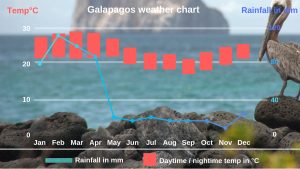
The warm season (Jan-Jun)
- Calm, clear, warm waters, great for snorkelling, often without a wet suit.
- Great weather, with February and March being the hottest and sunniest months with blue skies and sunshine.
Sea temperatures: 22-25°C / 72-77°F
Land temperatures: 21-32°C / 72-90°F
Green turtles: Mating occurs from December to February, and eggs are laid on beaches from January to March. The turtles hatch two months later.
The dry ‘garua’ season (Jun-Dec)
- It’s a great time for marine life in the cooler seas as plankton-rich, cooler waters circulate.
- Snorkellers may want a wetsuit.
Sea temperatures: 15-22°C / 60-72°F
Land temperatures: 18-24°C / 65-75°F
Baby sea lions: Mainly born in August. If you want to snorkel with these adorable animals, then November onwards is when the pups first start swimming and playing in the waves.
Whales: From June to September, the humpback migrates past the Galapagos, and some whale sharks may be spotted at this time, too.
What to Wear Snorkelling in Galapagos?
Most organised day trips and snorkels include a mask, snorkel tube, fins, and often a wetsuit for your snorkelling. Some people bring their own mask and tube, especially if they prefer the full-face masks that are increasingly popular.
Top snorkelling tips:
- Prevent fogging by cleaning the goggles or mask with an anti-fog cleaner before jumping in the water. Good old-fashioned spit works, too!
- Use a lifejacket. Floating devices and buoyancy aids are also useful.
- Fins are often easier to fit into once in the sea or in the zodiac. Walking in fins on land can be tricky.
- Wearing a T-shirt keeps you warm in the water and prevents your back from sunburn.
- Bring an underwater video camera to capture your adventure. You’ll regret it if you don’t!
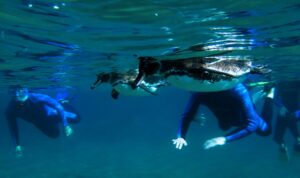
Currents in the Galapagos Islands
Many Galapagos snorkelling sites are in shallow water, in protected coves or beaches. Snorkelling here requires some simple swimming and moving around.
Open sea snorkels may be in deep water with possible currents. Snorkelling experience is optional for these places, but swimming skills are vital. Kicker Rock and Devil’s Crown are show-stopping snorkel sites but have currents that require respect.
Always ask your guide about currents and be honest about your capabilities.
If snorkelling independently, check with locals for currents, rip currents, tides, and other local swimming information before entering the water. Watch local conditions, and if unsure, do not enter the water. Never swim solo.
Top Tips for Snorkelling in the Galapagos Islands?
Remember!
The Galapagos National Park is carefully protected.
- You’ll need a guide on a cruise or day trip to access many snorkel sites.
- Beaches are sometimes closed, often to allow for turtles to nest.
- Visitor numbers are limited. That means most of the iconic snorkel sites, such as Kicker Rock, Bartolomé, and Tunneles, require advance booking to avoid disappointment.
- Bring strong, biodegradable, waterproof sun cream (factor 50), as the equatorial sun is strong.
- Seasickness pills help for cruises and day tours with long boat rides to sites. For example, you might be in a speedboat to a snorkel site for two hours and then have to make a two-hour return journey.
- Mosquito repellent is useful.
- Independently visiting beaches means walking, cycling, bussing, or hiring a taxi.
- Don’t touch, approach, or try to interact with any animals on the Galapagos, on land or sea.
Contact us for more about Galapagos holidays.
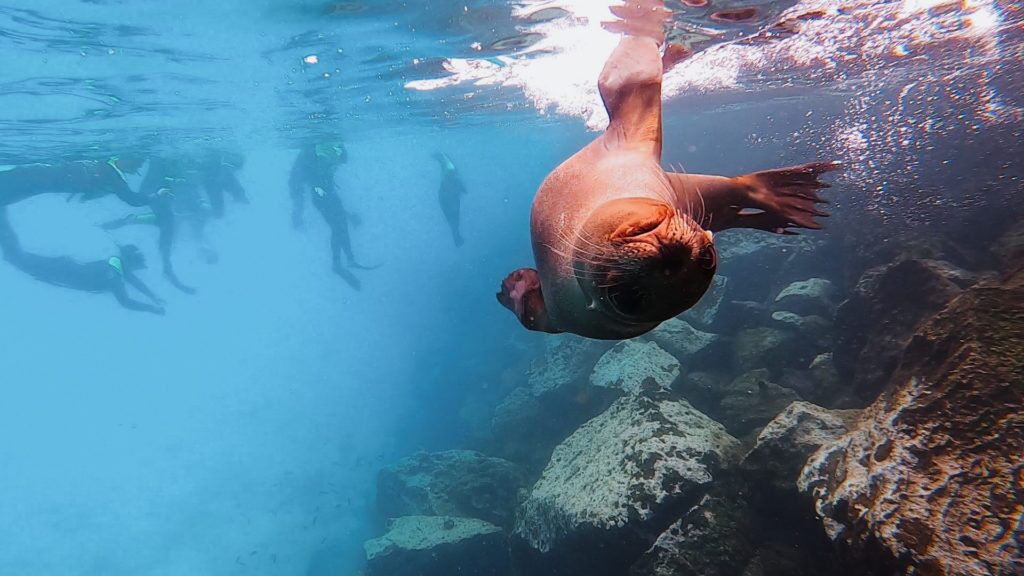
Share








